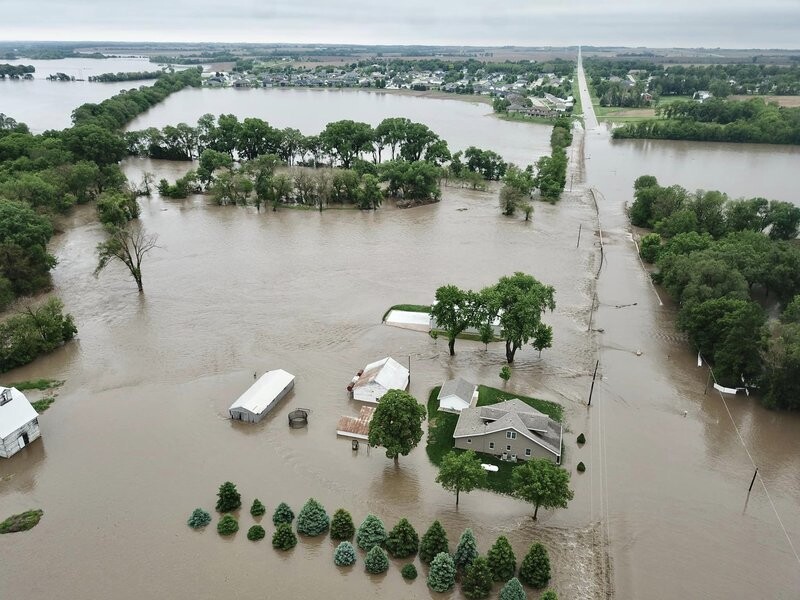
Lincoln, Neb. —Floodwater from the recent heavy rains, runoff, and even snowmelt may potentially carry multiple pollutants with it. During floods, water comes into contact with things it normally wouldn’t. This includes, but is not limited to untreated septic waste, animal waste, gasoline, chemical and fuel storage facilities and more. If your private drinking water well has been impacted by floodwater, your water supply may have been contaminated with pollutants carried in the floodwater.
Do not use the water for cooking, drinking, or brushing teeth until laboratory analysis confirms that it is safe. (See water treatment options, including shock chlorination.)
Wells at greatest risk of contamination from floodwater or surface water runoff include:
- All wells that were submerged with flood water or surface water runoff.
- Any well located in a pit. This is where a wellhead, and possibly other well equipment are located in a below ground enclosure.
- Dug wells or any wells that do not have a watertight casing.
- Any well that does not have watertight, secure cover or cap.
- Any well constructed prior to 1986. Prior to water well construction regulations in Nebraska, construction practices did not have a mandatory grout seal in the annular space around the well casing, making it less resistant to having surface runoff or floodwaters enter the well.
Managing Wells after a Flooding Event
If you know or even think that your private drinking water well was impacted by floodwater, follow the steps below. Only follow steps 4-8 if you are comfortable doing so.
- DO NOT USE well water for cooking, drinking, or brushing teeth until laboratory analysis confirms that it is safe.
- TURN OFF the power to all well equipment at the breaker panel.
- Electricity and water can create a dangerous situation. Wear waterproof, rubber-soled shoes or boots when inspecting around your wellhead and property.
- Determine whether the wellhead was flooded.
- Inspect your wellhead for floodwater or signs of flooding disturbance. If you were not present on the property during the flooding event. Debris and mud around the property and water or mud stains on the wellhead may indicate that the well was flooded.
- Contact a Nebraska licensed water well contractor if you do not have safe access to your wellhead.
5. Inspect the ground surface around the wellhead for erosion or instability.
- Inspect the area around your wellhead for erosion or breaks in the ground that may lead to unsafe conditions or a pathway for floodwater and contaminants to get in the well.
- If signs of contamination pathways exist, contact a Nebraska licensed water well professional.
6. Inspect the sanitary well cover/cap/seal and vent.
- Note if the cover/cap and seal are securely fastened to the well casing. Look to see if the vent are still intact. Sediment and debris may enter the well through a loose well cap or vent and contaminate it if the wellhead was submerged.
- If there is damage to the sanitary well cap and seal, or vent, and/or if there are signs that sediment and debris have entered the well, contact a Nebraska licensed water well contractor.
7. Inspect the well casing.
- Note if the exposed well casing appears to be bent, shifted, or cracked. Damages such as these may allow water, sediment, and debris to enter the well, thus increasing the risk of contamination.
- If signs of damage exist, contact a Nebraska licensed water well contractor.
8. Inspect electrical components, wiring, and conduit.
- Make sure that power has been shut off to the well. Note if there are any exposed/damaged wiring or electrical components. Did water enter any of the electrical components?
- If any water or damage is found, or if it is known/suspected that any part of the electrical system has been submerged, contact a Nebraska licensed water well professional.
Why it is Important to Contact a Nebraska Licensed Water Well Contractor for Further Inspection & Repairs and Next Steps:
- Nebraska licensed water well contractors know with Nebraska Regulations Governing Water Well Construction, Pump Installation, and Water Well Decommissioning Standards. They have gone through the examination process to become licensed to be a water well contractor in Nebraska.
- An experienced, Nebraska licensed contractor can identify problems that may not be apparent to the well owner.
- Clean out any debris or sediment that entered the well.
- Make repairs as necessary in accordance with state regulations.
- Disinfect the well with shock chlorination. The system must be flushed (three to four hours) after the disinfectant has been retained undisturbed in the system for six to eight hours to remove any debris and flush contaminates from the water system before testing for drinkability.
- Then, either the water well contractor or you needs to contact a certified testing laboratory and tell them you want to have your private water supply tested for bacteria due to flooding. They will provide a test kit with detailed instructions for collecting a sample and sample submission. (See list of certified laboratories.)
- Do not use the water from your well until the laboratory has informed you that it is safe and free of bacterial contamination. It may be necessary to repeat the disinfection and testing process several times before the well is free of contamination.
It is important to note that if floodwater came close to your well (100 feet or less) but did not reach the well, have your water tested as a precaution to protect the health of you, your family, and animals.
For more information on testing and treating water from a well that may have been contaminated by floodwater, see these UNL Extension NebGuides:
- Drinking Water Treatment
- Emergency Disinfection of Drinking Water
- Drinking Water: Testing for Quality
- Drinking Water: Bacteria
- Drinking Water Treatment: Shock Chlorination
More information can be found under Home, Health, and Safety – Water Well Safety at disaster.unl.edu
Peer reviewed by Bruce Dvorak.







